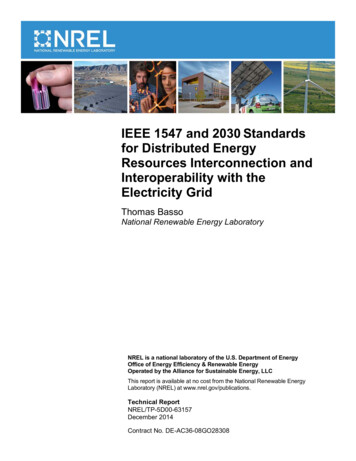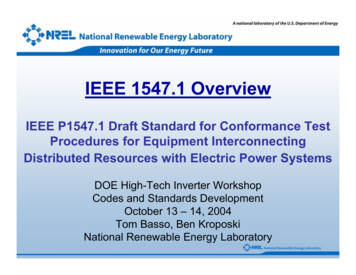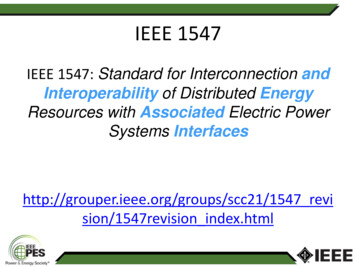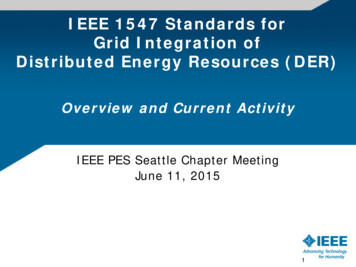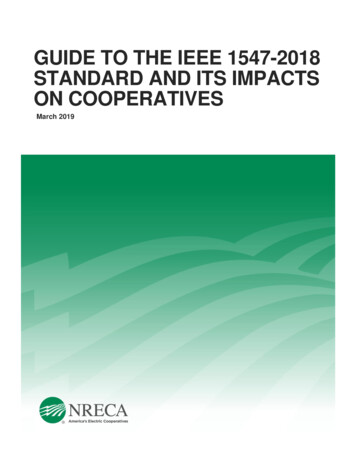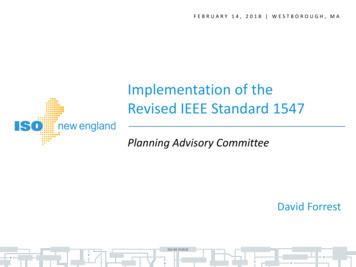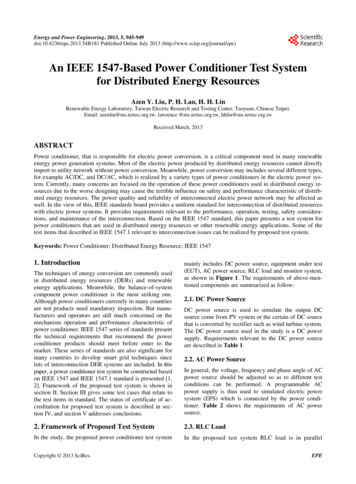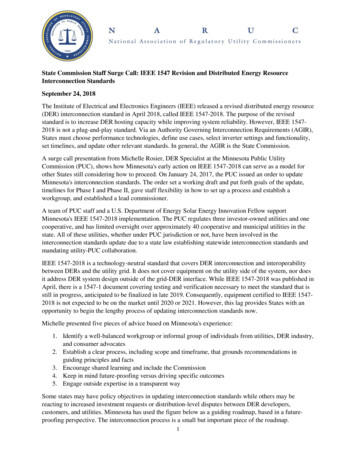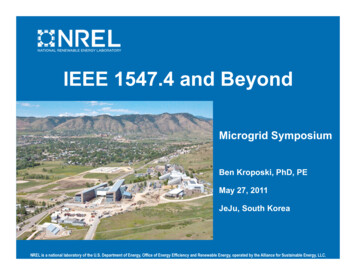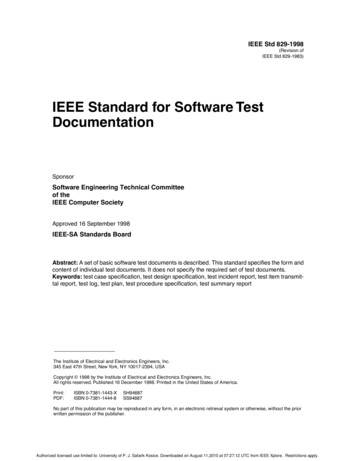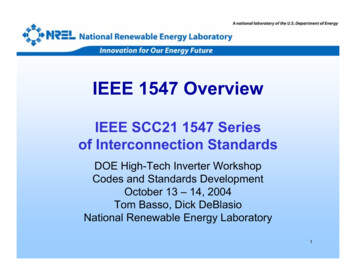
Transcription
IEEE 1547 OverviewIEEE SCC21 1547 Seriesof Interconnection StandardsDOE High-Tech Inverter WorkshopCodes and Standards DevelopmentOctober 13 – 14, 2004Tom Basso, Dick DeBlasioNational Renewable Energy Laboratory1
IEEE SCC21 1547 Series of Interconnection StandardsIEEE Std 1547TM (2003) Standard for InterconnectingDistributed Resources with Electric Power SystemsGuide for ImpactsGuide for NetworksP1547.4 Draft Guide forP1547.3Draft Guide for Monitoring,Information Exchange andControl of DRInterconnected with EPSP1547.2Draft ApplicationGuide for IEEEP1547 DraftStandard forInterconnectingDistributedResources withElectric tionDesign, Operation, andIntegration of DistributedResource Island Systems withElectric Power SystemsDP Specifications and Performance(includes modeling)P1547.1Draft Standard forConformance TestProcedures forEquipmentInterconnectingDistributedResources withElectric PowerSystemsThe above identifies existing IEEE SCC21 standards development projects (1547 series)and activities under discussion by SCC21 Work Group members.
IEEE P1547.5 ProjectTitle. P1547.5 Draft Technical Guidelines for Interconnection ofElectric Power Sources Greater than 10MVA to the PowerTransmission GridScope. This document provides guidelines regarding the technicalrequirements, including design, construction, commissioningacceptance testing and maintenance /performance requirements, forinterconnecting dispatchable electric power sources with a capacity ofmore than 10 MVA to a bulk power transmission grid.Purpose. The purpose of this project is to provide technical informationand guidance to all parties involved in the interconnection ofdispatchable electric power sources to a transmission grid about thevarious considerations needed to be evaluated for establishingacceptable parameters such that the interconnection is technicallycorrect.Sponsor: SCC21 - Fuel Cells, Photovoltaics, Dispersed Generation, andEnergy StorageSponsoring Committee Chair: Dick DeBlasioPAR approved by IEEE September 2004 (project authorization request);ballot to be completed by December 2007.3
Content¾ Background¾ IEEE Standards¾ 1547 Series of Standards ANSI/IEEE Std 1547 (2003): Standard for interconnectionsystem & interconnection test requirements forinterconnecting DR with Electric Power Systems (EPS) P1547.1 Standard for interconnection test procedures P1547.2 Guide to 1547 standard P1547.3 Guide for information exchange for DRinterconnected with EPS P1547.4 Guide for DR island systems P1547.5 Guide for interconnection to transmission grid4
Bulk PowerTransmission andDistribution SystemSubstationssensorsTransmission SystemCommunications – Information Flow, DataManagement, Monitor & ctionDistributed GenerationCombined Heat& Power5sensors
Interconnecting Power SystemsThe overall power system is traditionally viewed in terms of7 layers; each performing its function from central station 6generation supplying power out to customers.
Traditional Approach:Independent TechnologiesDistributionSubstation138 kV - 12 kVDERDE Technology PlatformSMARTConnect Technology PlatformDistribution Feeder12 stemSMARTConnectTechnology PlatformTechnology PlatformInterconnection SystemTechnology PlatformInterconnectionSystemDERInterconnection System7
Technology PlatformsA natural evolution of technology developmentDistributionSubstationPower PlantInterconnection SystemTechnology DE logyPlatform8
Standards BenefitsStandards Development, Validation, and Use¾ Safeguards against hazards¾ Fosters quality design and manufacture¾ Increases competitiveness in industry¾ Creates and expands markets¾ Facilitates Trade and Commerce¾ Assurance is provided when products meet qualitystandards, then users need not be concerned withfurther testing or evaluation of the product9
Standards BenefitsStandards Development, Validation, and Use¾Accelerates engineering advances & implementation,interoperability, and installation¾Assists increased quality and reliability achievement¾Simplifies compliance to needs, permitting, & rules¾Promotes advanced communications; softwareplatforms interchangeability¾Enables enhanced DR systems and grid intelligence¾Lower cost and quicker deployment for projects. 10
Standards DevelopmentNational consensus standards established via industrydriven partnerships; balanced stakeholder participation.Harmonization of national and international standards,codes, and certification/laboratory accreditation, e.g.,International Electro-technical Commission (IEC) dual logoarrangement for IEC to adopt IEEE standards for electronics,telecom, and power generation.IEC TC 82 Photovoltaics – US is Secretariat for IEC/TC82.IEC TC 8 System Aspects of Electrical Energy Supply:TC8 facilitates functioning of electricity supply systems –systems encompass T&D networks including interfaces withuser installations (generators and consumers).IEC Joint Coordinating Group (JCG) on Distributed RuralElectrification Systems for international stds. development.11
Institute of Electrical andElectronic Engineers - IEEE IEEE - international technical professional society More than 375,000 members from 150 countries Advances the theory and application of electrotechnologies and allied sciences Produces over 30% of world’s published literaturein electrical engineering, computers, and controls One of the pre-eminent standards bodies12
IEEE Definitions/ProtocolsIEEE Classification of Standards DocumentsStandards: documents with mandatory requirements (shall).Recommended Practices: documents in which procedures andpositions preferred by the IEEE are presented (should).Guides: documents in which alternative approaches to goodpractice are suggested but no clear-cut recommendations aremade (may).IEEE Ballot ConsensusVoter group balanced: each interest group 50% of total(users, manufacturers, general interest); voter may providecomments, sponsor responds to each negative statingsponsor position on comments, sponsor re-circulatesunresolved negatives to allow balloters to change their vote;minimum of 75% affirmation needed to pass to IEEE13Standards Board for their approval.
IEEE Standards Board Approves all IEEE standards projects andstandards for publication. Establishes Standards Coordinating Committees(SCC) that report directly to Board. Established new liaison to DOE (R. DeBlasio,Chair SCC21) IEEE standards are recognized nationally andworldwide- IEEE standards may qualify as AmericanNational Standard (ANSI/IEEE status)- IEEE and IEC dual logo arrangement14
IEEE Standards Coordinating Committee 21SCC21 Fuel Cells, Photovoltaics,Dispersed Generation, & Energy StorageScope and Purpose.SCC21 Oversees the development of standards in theareas of Fuel Cells, Photovoltaics, DispersedGeneration, and Energy Storage, and coordinates effortsin these fields among the various IEEE Societies andother affected organizations to ensure that all standardsare consistent and properly reflect the views of allapplicable disciplines.SCC21 reviews all proposed IEEE standards in these fieldsbefore their submission to the IEEE-SA Standards Boardfor approval and coordinates submission to otherorganizations.15
SCC21 1547 Development Approach SCC 21 building on long history of DRstandards, e.g., IEEE Std 1001 — Guide for Interfacingdispersed storage and generation with electric utilitysystems; IEEE Std 929 — Recommended Practice for UtilityInterface of PV Systems; IEEE Std 1547 Standard forInterconnecting Distributed Resources with Electric PowerSystems; IEEE P1547.x series of interconnection standards National Consensus Standards; Industry Driven 400 SCC21 work group members (all groups most with 1547 Series of InterconnectionStandards; photovoltaics/energy storage16
1547 Development ApproachIEEE Std 1547 (Interconnection Standard) -- approved startMarch 1999; Chair: R. DeBlasio, NREL; over 500 volunteershave worked on developing or balloting the standard.P1547.1 (Test Standard) -- approved start June 2001; Chair:J. Daley, ASCO Power Technologies, Inc., 82 members.P1547.2 (Guide to Std 1547) -- approved start December 2001;Chair: N. R. Friedman, Resource Dynamics Corporation, 96members.P1547.3 (Guide for Monitoring, Information Exchange, andControl) -- approved start June 2002; Chair: F. Goodman,EPRI, 95 members.P1547.4 (Islanding Systems) – approved start Dec. 2003;Chair: B. Kroposki, NREL (establishing membership).IEEE/1547 members identified additional priority standardsneeds (e.g., see 1547 series graphic).17
ANSI/IEEE Std (2003)18
American National StandardANSI/IEEE 1547 StdIEEE Std 1547 (2003) published summer 2003Affirmative IEEE Ballot February 2003- Voting Membership¾ 230 members (31% general interest, 4% government,30% manufacturer/producer, 35% utility/user)¾ 91% affirmatives- 444 Work Group & Ballot Group Members at time of ballot Approved by IEEE Standards Board June 12, 2003 American National Standard designationÆ ANSI/IEEE Std 1547 - October 20, 2003 Å19
Some Key 1547 Development Issuesissues not normally addressed as IEEEuniversal, mandatory requirements Federal/State Implementation and Impacts (rules) Fully Commercialized/Certified Products, After Sale Support, Warranties Liability (DG vs. grid operators) Functionality of Interconnection Package (always more to add) Lower Interconnection System Cost Cost of EPS Re-Fit (how and who pays) Operation (which standard and who is in control) Reliability (operational issues – durability vs. availability) Misunderstanding/Misapplication (limited experience/knowledge) User Disagreement (not all utilities and DGs are alike)20
Some Key 1547 Development Issuesthat would benefit from further R&D activities Develop improved interconnection technology Address field testing vs. type testing Interconnection equipment certification Evaluate secondary grid and spot networks Develop grid/DG monitoring and control Understand voltage regulation/stability Address grounding/faults Establish basis for DG penetration/aggregation Develop islanding methods and requirements21
More Key 1547 Development Issuese.g., Grid Modernization, beyond distribution system,DR/interconnection advances: 1547 revision? additionsto 1547 series?Research on, and Validation of DR Integration,Advanced EPS/Distribution Operating Concepts: IEEE 1547 covers Unintentional Islanding, IntentionalIslanding, Secondary Networks, and Spot Networks. Current version of IEEE 1547 minimizes the utilization ofdistributed resources in the event of system disturbances. Research on system integration of DR with all types ofEPS/distribution operational concepts to revise IEEE 1547 tomaximize the use of DR and realize the potential operational22benefits at the transmission and distribution level.
IEEE SCC21 1547 Series of Interconnection StandardsIEEE Std 1547TM (2003) Standard for InterconnectingDistributed Resources with Electric Power SystemsGuide for ImpactsGuide for NetworksP1547.4 Draft Guide forP1547.3Draft Guide for Monitoring,Information Exchange andControl of DRInterconnected with EPSP1547.2Draft ApplicationGuide for IEEEP1547 DraftStandard forInterconnectingDistributedResources withElectric tionDesign, Operation, andIntegration of DistributedResource Island Systems withElectric Power SystemsDP Specifications and Performance(includes modeling)P1547.1Draft Standard forConformance TestProcedures forEquipmentInterconnectingDistributedResources withElectric PowerSystemsThe above identifies existing IEEE SCC21 standards development projects (1547 series)and activities under discussion by SCC21 Work Group members.
CurrentSCC21InterconnectionInterconnection ProjectsCurrentSCC21ProjectsTitleScope & PurposeIEEE Std 1547TM (2003)Standard forInterconnectingDistributed Resourceswith Electric PowerSystems(published June 2003) This Standard establishes criteria and requirementsfor interconnection of distributed resources (DR) withelectric power systems (EPS). This document provides a uniform standard forinterconnection of distributed resources with electricpower systems. It provides requirements relevant to theperformance, operation, testing, safety considerations,and maintenance of the interconnection.P1547.1 Draft Standardfor Conformance TestProcedures forEquipmentInterconnectingDistributed Resourceswith Electric PowerSystems This Standard specifies the type, production, andcommissioning tests that shall be performed todemonstrate that interconnection functions andequipment of a distributed resource (DR) conform toIEEE Std 1547. Interconnection equipment that connects distributedresources (DR) to an electric power system (EPS) mustmeet the requirements specified in IEEE StandardP1547. Standardized test procedures are necessary toestablish and verify compliance with thoserequirements. These test procedures must provide bothrepeatable results, independent of test location, andflexibility to accommodate a variety of DR technologies.
CurrentSCC21InterconnectionInterconnection ProjectsCurrentSCC21ProjectsTitleP1547.2 TM DraftApplication Guide forIEEE Standard 1547for InterconnectingDistributedResources withElectric PowerSystemsScope and Purpose This Guide provides technical background and applicationdetails to support the understanding of IEEE 1547 Standard forInterconnecting Distributed Resources with Electric PowerSystems. This document facilitates the use of IEEE 1547 bycharacterizing the various forms of distributed resourcetechnologies and the associated interconnection issues.Additionally, the background and rationale of the technicalrequirements are discussed in terms of the operation of thedistribute
IEEE/1547 members identified additional priority standards needs (e.g., see 1547 series graphic). 18 ANSI/IEEE Std (2003) 19 American National Standard ANSI/IEEE 1547 Std IEEE Std 1547 (2003) published summer 2003 Affirmative IEEE Ballot February 2003 - Voting Membership ¾230 members (31% general interest, 4% government, 30% manufacturer/producer, 35% utility/user) ¾91%
